
Growth in Middle-Income Countries
 The Middle-Income Trap
The Middle-Income Trap

Middle-income countries—home today to 6 billion people—are in a race against time. Many have set ambitious deadlines for themselves: reach high-income status within the next two or three decades. That will not be easy. Since the 1990s, only 34 middle-income economies have succeeded in that feat. The rest—108 at the end of 2023—have been stuck in “the middle-income trap”. Since 1970, the median income per capita of middle-income countries has never risen above 10 percent of the US level.
Climbing to high-income status in today’s environment will be harder still—because of high debt and aging populations in developing countries and growing protectionism in advanced economies. World Development Report 2024: The Middle-Income Trap outlines how all developing economies can avoid the middle-income trap.
Depending on their stage of development, countries need to adopt a sequenced and progressively more sophisticated mix of policies, shifting from a 1i (investment) approach to a 2i (investment + infusion) to a 3i (investment + infusion + innovation) approach. Moreover, the handful of countries that have made speedy transitions from middle- to high-income status have done so by disciplining vested interests, building their talent pool, and modernizing policies and institutions. Today’s middle-income countries can do the same.
Download Report Overview Key Policy Messages
Key Policy Messages
This section summarizes the high-level policy messages from The Middle-Income Trap. Click on each card to read more.
Low-income countries can focus solely on policies designed to increase investment—the 1i approach.

Low-income countries can focus solely on policies designed to increase investment—the 1i approach.
Countries growing out of low-income status into middle-income status tend to have a 1i strategy for accelerating investment. They should:
- Improve the investment climate to increase domestic and foreign investment.
- Invest in human capital by broadening foundational skills and improving learning outcomes.
- Increase investment in expanding access and grid networks.
- Reform regulatory frameworks to attract private investment and ensure fair competition.
Lower-middle-income countries must expand the policy mix to a 2i approach—investment + infusion.

Lower-middle-income countries must expand the policy mix to a 2i approach—investment + infusion.
Lower-middle income countries should:
- Discipline market leaders through integration into globally contestable markets; diffuse global technologies; and reward value-adding firms.
- Discipline elites by providing equal opportunities for women and disadvantaged groups; allocate talent to task; develop links within academia; and allow emigration of educated workers whose skills are not valued in domestic markets.
- Discipline SOEs by hardening budget constraints; advocate for advanced economies to ease protection of domestic incumbents; boost energy efficiency; and reflect environmental costs in energy prices.
Upper-middle-income countries need to shift gears yet again, to a 3i strategy: investment + infusion + innovation.

Upper-middle-income countries need to shift gears yet again, to a 3i strategy: investment + infusion + innovation.
Upper-middle-income countries should:
- Deepen capital markets and expand equity financing; strengthen antitrust regulation and competition agencies; and protect intellectual property rights.
- Strengthen industry-academia links domestically; expand programs to connect with diaspora in advanced economies; and enhance economic and political freedoms.
- Lower the cost of capital for low-carbon energy by reducing risks involving technology, markets, and policy; and increase multilateral finance for very long-term investments.
Countries that have made speedy transitions from middle- to high-income status have disciplined domestic vested interests.
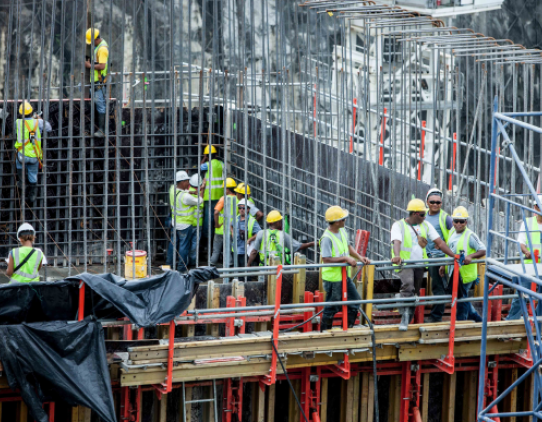
Countries that have made speedy transitions from middle- to high-income status have disciplined domestic vested interests.
Powerful incumbents—large corporations, state-owned enterprises, and powerful citizens—can add immense value, but they can just as easily reduce it. Governments must devise mechanisms to discipline incumbents through competition regimes that encourage new entrants without either coddling small- and medium-size enterprises or vilifying big corporations.
Countries should reward merit to build their talent pool.

Countries should reward merit to build their talent pool.
Middle-income countries have smaller reservoirs of skilled talent than advanced economies and are also less efficient at utilizing them. So they will have to become better at accumulating and allocating talent.
Countries should capitalize on crises as opportunities to modernize policies and institutions.

Countries should capitalize on crises as opportunities to modernize policies and institutions.
Cheap, reliable energy has long been a cornerstone of rapid economic development. But prospering while keeping the planet livable will now require paying greater attention to energy efficiency and emissions intensity. Climate change and other exigencies can provide opportunities to forge the consensus needed for tough policy reforms.
 Multimedia
Multimedia
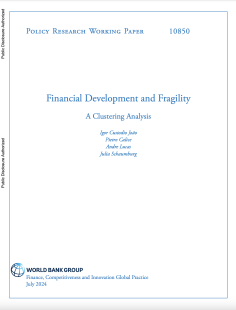
Policy Research Working Papers
Financial Development and Fragility : A Clustering Analysis
This paper explores the potential correlations between financial development and state fragility, using a sample of 137 countries observed over the period from 1998–2019. The countries are grouped into clusters that capture the different joint states of financial development and fragility. The paper introduces a new switching methodology to further allow for a qualification of the evolution of countries in terms of fragility scores with and without controlling for other variables. Irrespective of the precise methodology and state fragility measure as used in this paper, the findings indicate a negative correlation between financial development and state fragility, after controlling for several forms of observed and unobserved heterogeneity.
Read more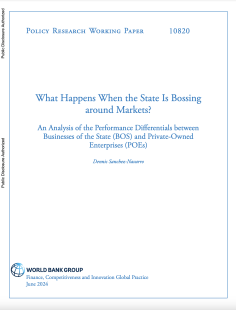
Policy Research Working Papers
What Happens When the State Is Bossing around Markets ? An Analysis of the Performance Differentials between Businesses of the State (BOS) and Private-Owned Enterprises (POEs)
This paper studies the performance differentials between privately-owned enterprises and businesses of the state. Businesses of the State (BOS) are firms with 10 percent or more direct or indirect state participation. By analyzing firm-level data across 16 European countries between 2011 and 2020, the paper finds evidence that state ownership matters for operational and financial performance and sheds light on how and when it matters.
Read more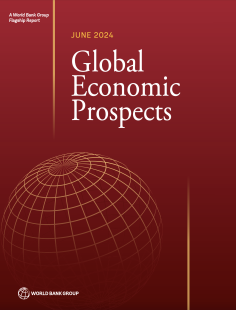
Publications
Global Economic Prospects, June 2024
This latest edition of the semi-annual Global Economic Prospects report projects that growth will hold steady at 2.6 percent this year. The report also includes a special analytical focus on two topical issues – harnessing the benefits of public investment, and strengthening resilience in small states, which face intense fiscal challenges.
Read more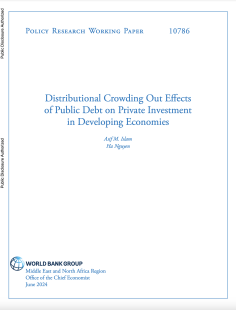
Policy Research Working Papers
Distributional Crowding Out Effects of Public Debt on Private Investment in Developing Economies
The Covid-19 pandemic, followed by financial tightening due to inflationary pressure, has raised public debt in developing economies as governments grapple with public health investments to curb the pandemic and collapse in revenues due to slower economic activity. The rise in debt may further disrupt the formal private sector in developing economies. Using two to three waves of panel firm-level data across developing economies, this study finds that higher public debt is correlated with low investment by formal private sector firms.
Read more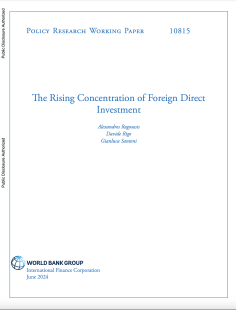
Policy Research Working Papers
The Rising Concentration of Foreign Direct Investment
Using two decades of granular data on foreign direct investments, this study shows a consistent global rise in the concentration of cross-border investments within fewer multinational firms. This concentration is most prominent in developing economies, reaching record highs in recent years. Structural shifts into services do not stand out as the primary driver of variation in investment concentration across countries and over time. Instead, concentration has grown significantly more in destinations facing high economic uncertainty.
Read more